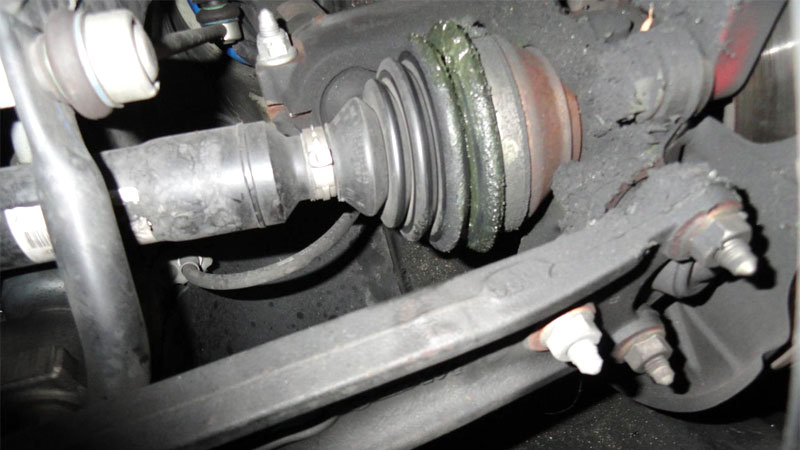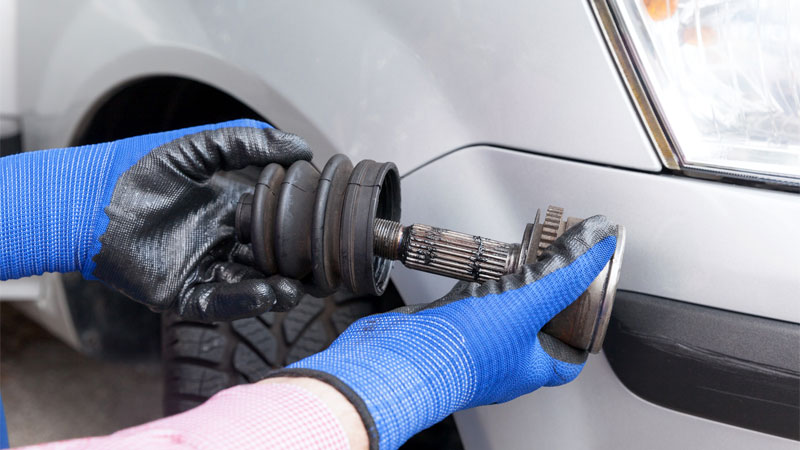Today’s vehicles are finely tuned pieces of equipment, featuring a wide array of individual components, all of which must function flawlessly to facilitate proper operation. If any one of these components were to fail, a number of serious mechanical issues could arise.
One such component of value, which must function flawlessly is the CV (constant velocity) axle. Front wheel drive vehicles rely upon a pair of CV axles to relay power from the unit’s transmission to each independent drive wheel. As such, it is imperative for a vehicle’s CV axles to be maintained in optimal condition.
Unfortunately, CV axles are prone to mechanical failure on occasion, especially when their joints become dry and lack sufficient lubrication. When these joints begin to fail, a number of troubling symptoms often arise, causing ample concern among most motorists.
Read on to learn more about the signs and symptoms of a bad CV joint, as well as how to address such a situation, should it arise in the future.
See Also – 7 Signs You Have a Transmission Problem
What is a CV Joint?
A CV (constant velocity) joint, also known as a half-shaft, is responsible for distributing power from a vehicle’s transmission to its drive wheels in FWD vehicles. A FWD vehicle features 2 independent CV shafts, one of which is located between the vehicle’s transmission, and each front wheel.
The true value of a CV joint comes in its ability to flex and articulate with the upward and downward movement of a vehicle’s suspension. This is achieved, all while continuing to provide power to each drive wheel.
In order for this level of articulation to be maintained, each individual joint must remain greased and free of contaminants.
This is achieved through the use of a specialized rubber boot, which features an accordion-style diaphragm. Grease is maintained within this boot at all times, assuming that the boot itself is kept in optimal shape.
Bad CV Joint Symptoms
A bad or faulty CV joint is often accompanied by one or more secondary symptoms. Learning to recognize these symptoms can prove imperative when attempting to diagnose the issue at hand, thereby returning a vehicle to service as quickly as possible.
The following are several of the most common symptoms associated with CV joint failure.
Read Also – Symptoms of a Bad Control Arm
1. Unusual Clicking Noises
One common symptom associated with a bad CV joint is a clicking noise that is most pronounced when cornering.
This sound only tends to increase with intensity over time, becoming extremely evident to those within close proximity to the affected vehicle at certain times.
2. Vibration At Speed
In certain cases, a compromised CV joint can cause noticeable vibration when cruising at speeds in excess of 40 MPH. While this particular symptom is not evident in every case, it does tend to be prominent enough to warrant one’s attention.
3. Displaced Grease
Displaced grease within a vehicle’s wheel well and undercarriage area is yet another sign of CV joint issues. In such instances, this “slinging” of grease indicates a broken CV boot.
If caught early enough, the damaged boot in question can simply be replaced. However, continued vehicle operation without replacement will eventually cause damage to the affected CV joint.
4. Knocking Noise When Turning
Much like the clicking mentioned above, a severely worn CV joint can actually present a knocking noise of sorts, which becomes quite obvious to motorists.
Again, this noise will only get worse with each passing mile and should be addressed as soon as possible.
Read Also – 4 Symptoms of a Bad Tie Rod
What Causes CV Joint Failure/Damage?
The most common cause of CV joint failure is the deterioration of a corresponding boot that encompasses such a joint. When a CV joint boot becomes damaged, all grease held within will quickly dissipate. This, in turn, causes CV joint dryness and binding.
Additionally, a busted CV joint boot will allow contaminants, such as road debris, to come into contact with the joint itself.
CV joints are also prone to accelerated wear when placed at extreme angles. This is most commonly observed in the case of lifted vehicles, which typically feature aftermarket suspension components.
How to Tell Which CV Joint Is Bad
There are a couple of ways that one can determine which of their vehicle’s CV joints is bad. The first is through careful visual inspection.
One should carefully inspect for any damage to inner or outer boots on either CV axle. Likewise, it is also important to check for signs of fresh grease that has been slung from any of these boots.
Alternatively, a vehicle’s front end can be lifted and supported to allow one to inspect for excess play in individual CV joints. With a vehicle elevated, each front tire can be spun while attempting to twist the CV shaft in the opposite direction by hand.
Excess free-play should be felt in any affected CV joint.
Bad CV Joint vs Bad Wheel Bearing
The most common difference between a bad wheel bearing and a bad CV joint is the type of noise that each mechanical failure produces.
In most cases, a worn or faulty wheel bearing will make a roaring or growling noise, while a damaged CV joint will produce a noise that is best described as a clicking of sorts. Additionally, the noise produced by a wheel bearing failure is more commonly heard from within the cabin of a vehicle.
In certain cases, a faulty CV joint can actually cause a vehicle’s wheel to shake or vibrate, especially at speeds exceeding 40 MPH. On the contrary, a bad wheel bearing will seldom cause the vibration of this particular type.
CV Joint Replacement Cost
The cost associated with replacing a faulty CV joint often varies from one particular vehicle to the next. This is due to differences in billable labor time that is applied to a repair of this type, on a case-by-case basis.
Actual CV joint replacement cost also tends to vary based upon a shop’s hourly labor rate, and the cost of the parts associated with completing such a job.
Nonetheless, the cost of CV joint replacement generally falls within a price range of $200-$800, with somewhere in the ballpark of $450 serving as a good average figure. As a general rule, the price of labor accounts for a far great amount of these costs than the price of parts/
Should CV Joints Be Replaced In Pairs?
It is always a good idea to replace CV joints or CV axles in pairs. This is due to the fact that under most circumstances, each of a vehicle’s two axles will incur approximately the same amount of wear within a given time frame.
While it is true that one specific axle might show obvious signs of impending failure first, one can bet good money that the opposing axle is not far behind.
Replacing both of a vehicle’s CV joints in tandem can save a significant amount of time and money, in the event that a non-replaced axle or joint were to fail within weeks to months following the replacement of the opposing unit.
This practice will eliminate any unnecessary vehicle downtime and will keep you on the road.
- The History of the BMW M Coupe (the “Clown Shoe”) - Mar 26, 2024
- The History of the Ford Flex - Feb 28, 2024
- Can You Trade In a Car With Body Damage or Mechanical Issues? - Feb 21, 2024







Good day Mr. Cooper! The information you’ve provided has been extremely beneficial! My 2012 Toyota Corolla has been shaking and can’t accelerate when driving, I’ve been hearing a clicking noise but no one seemed to know what the problem was! I now know what to tell them what the problem is! Praise the Lord I’ve came across your article! You are very knowledgeable and I’m extremely grateful!
Thanks!😊
My 2010 Chrysler Sebring is making an unusual clunky noise when I make a deep right and left turns, also a general noise comes from under the front of my vehicle when I drive on a bad section of the road. Please give me your opinion as to what I should be looking for as the possible problems. By the way I have just replaced the power steering fluid, but I did not bleed the line. The power steering pump was making some noise at first, but eventually stopped.
My 2009 Hyundai elantra swearved to the left when I brake. I havchanged back and front brakes..new tires..alligned..new struts..the list goes on and on and the problem is still there. Taken it to the dealer ..same answer..need brakes. HELP.
Hi, I’m an enthusiast. Wondering if the brakes are not coming on at the same time on both left and right wheels. Might be possible to jack up the car, have someone run the engine at reasonable rpm (aro 1200) with drive engaged, apply brakes and observe what’s happening to the wheels. Both should stop simultaneously and firmly . The non driven wheels should remain stationary and not movable. Pls first check with tech to make sure this procedure is feasible and not totally crazy!